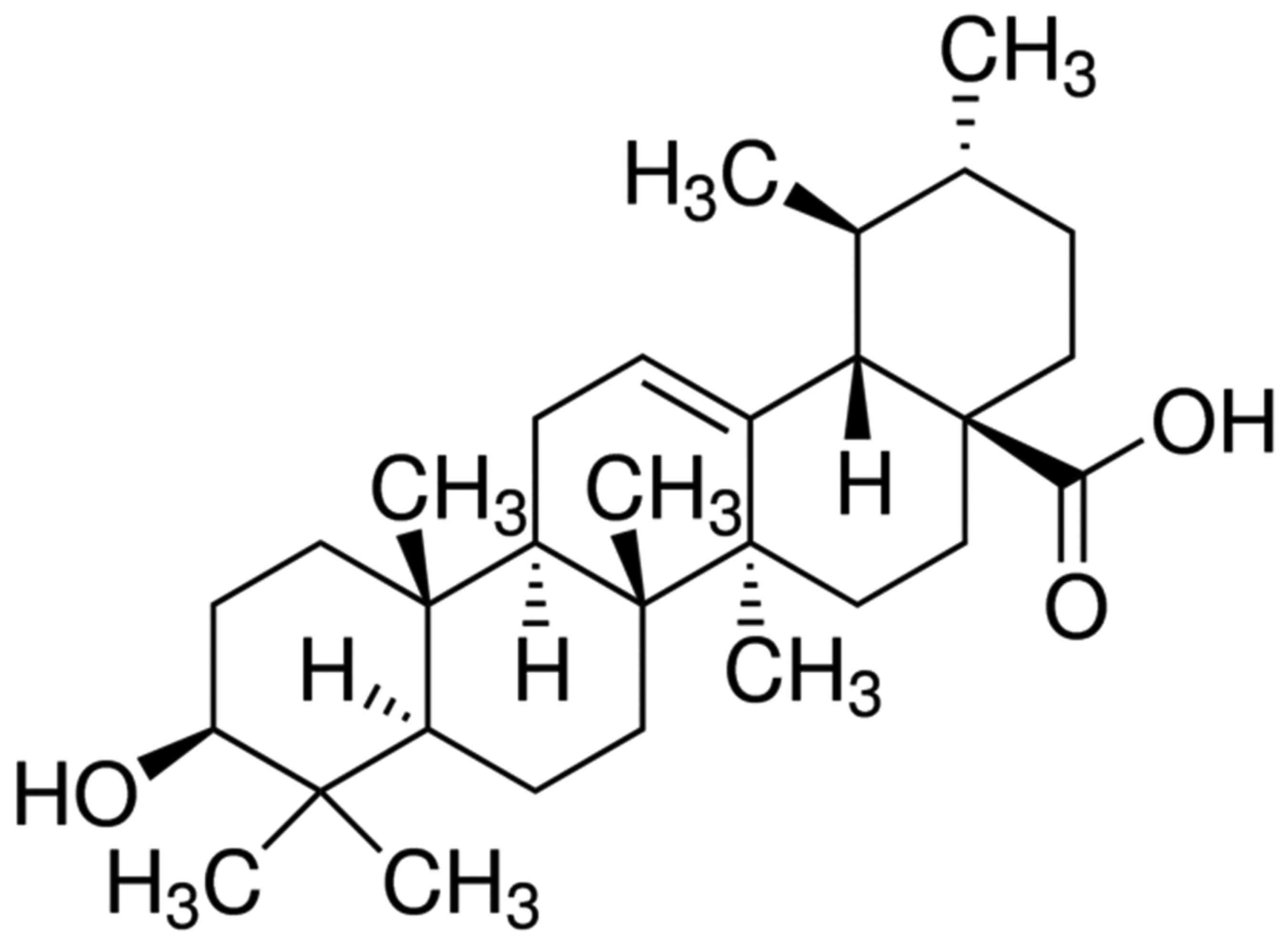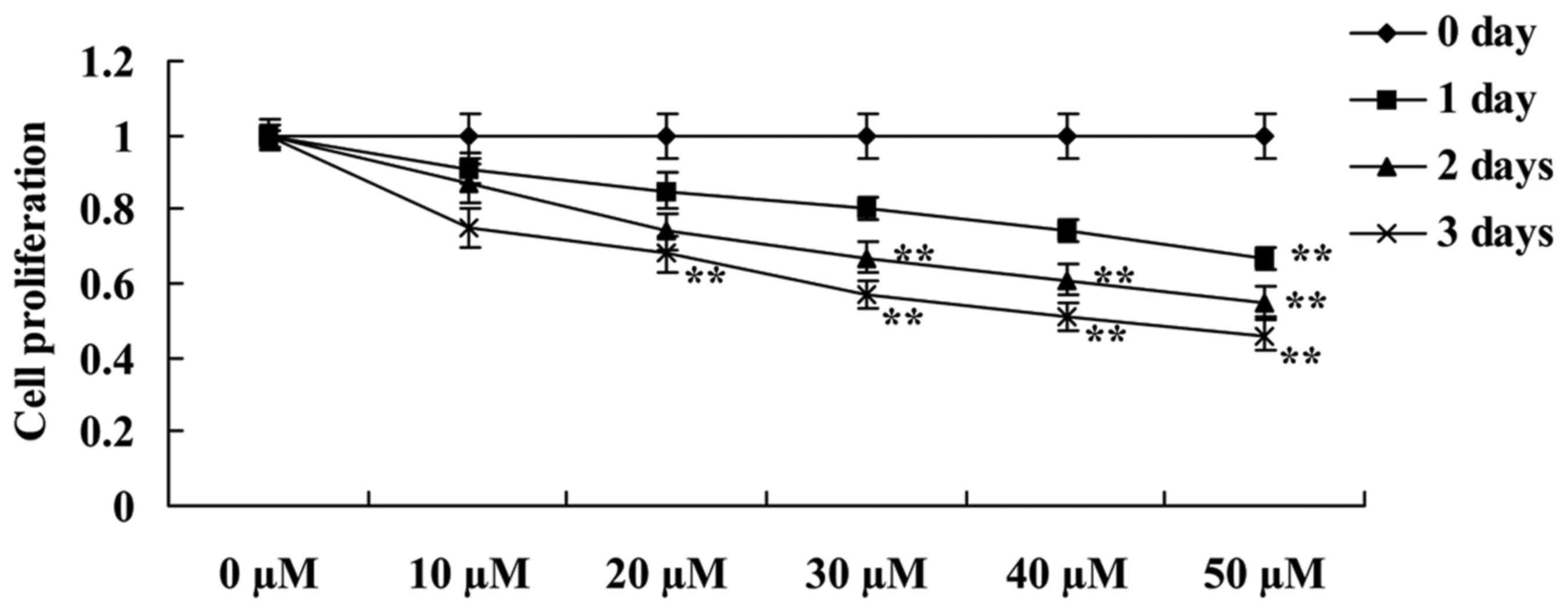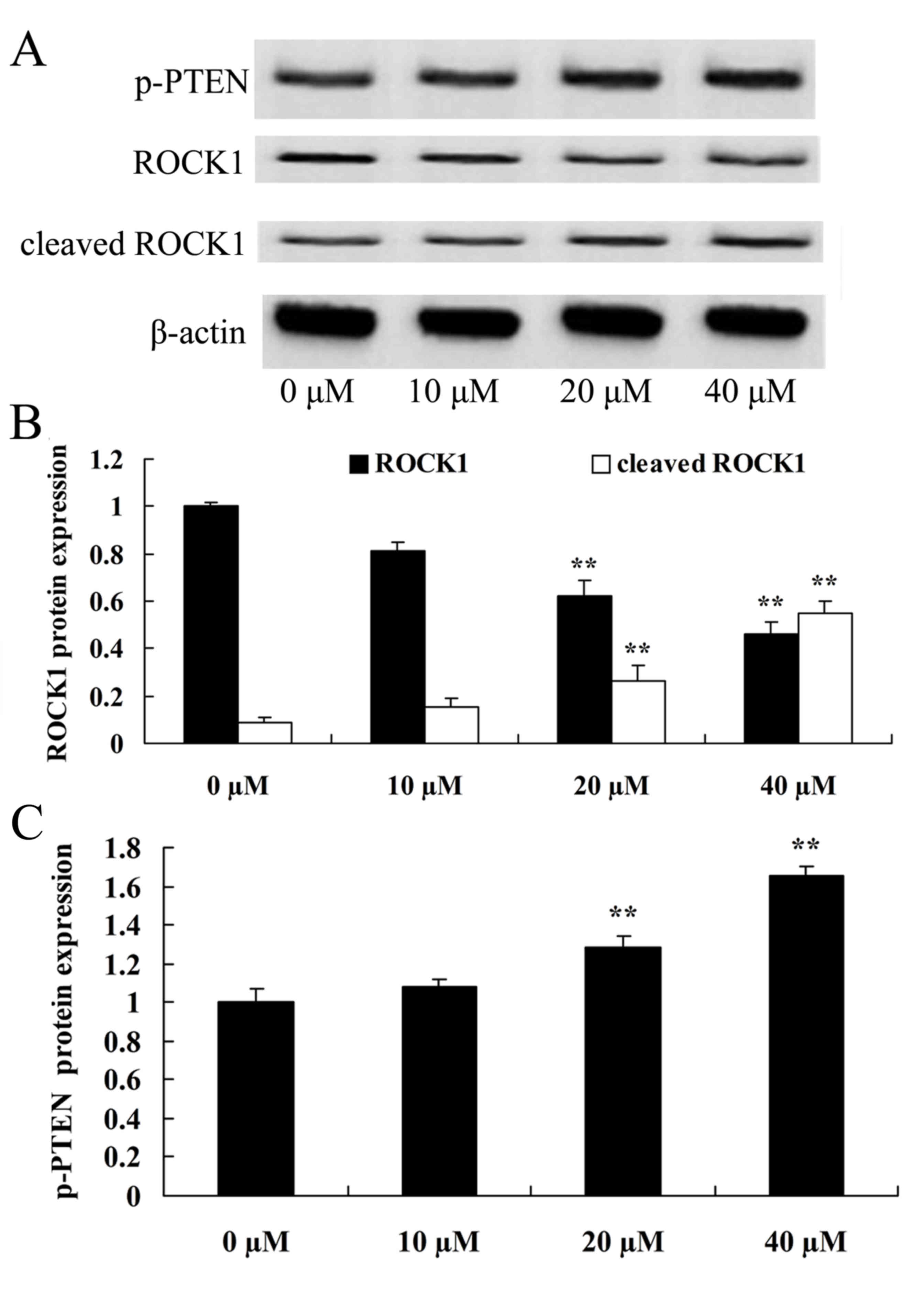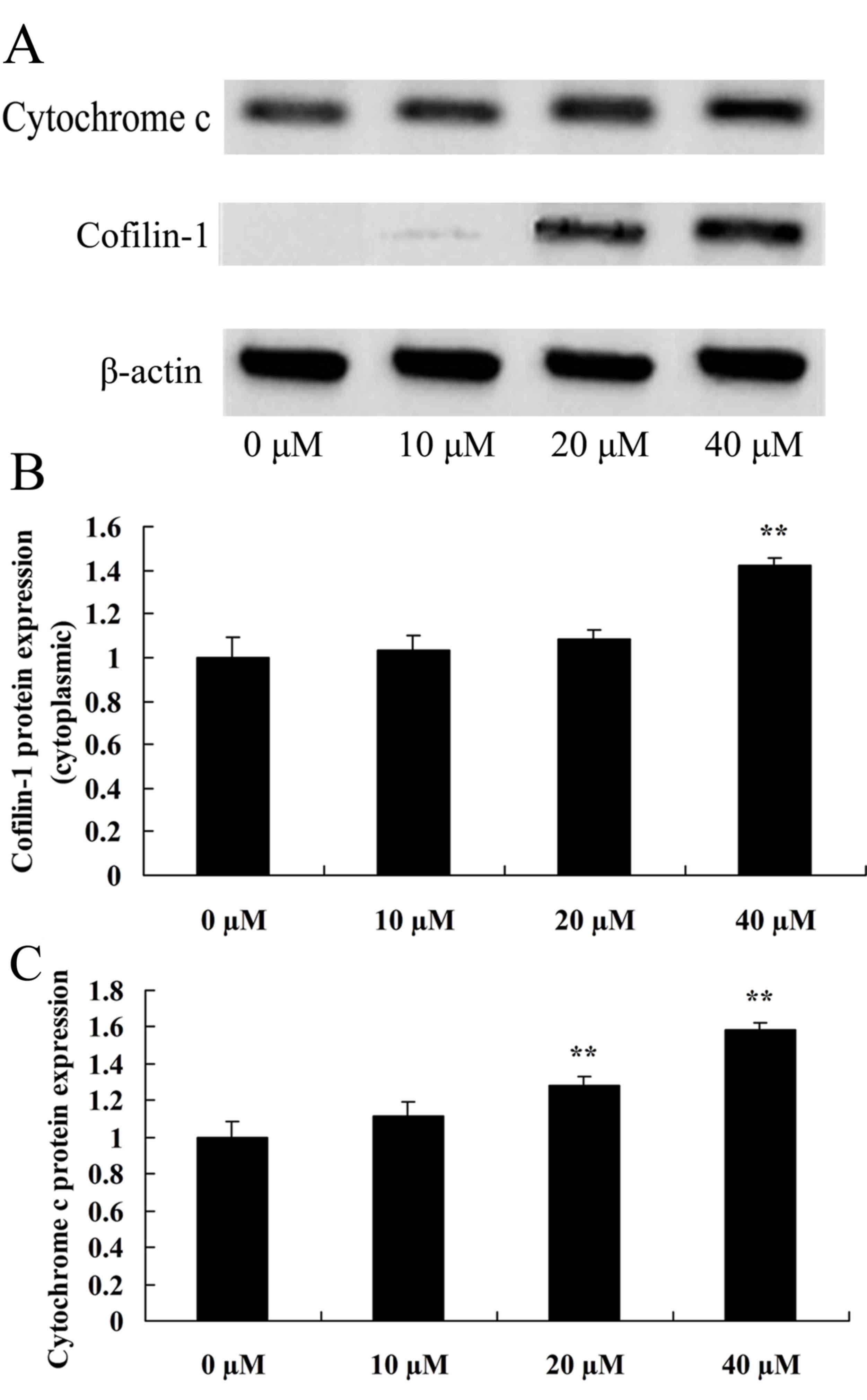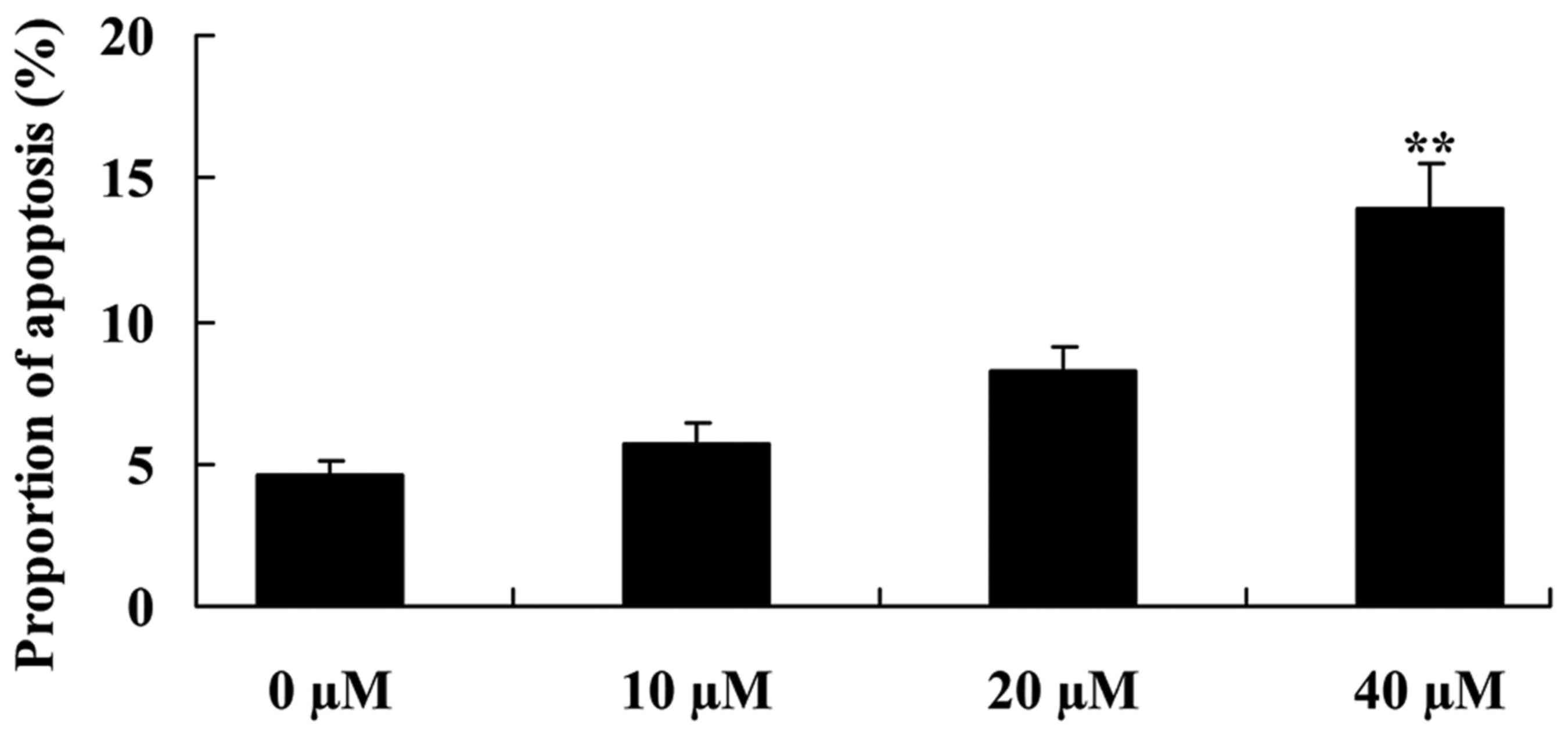Ursolic acid activates the apoptosis of prostate cancer via ROCK/PTEN mediated mitochondrial translocation of cofilin-1
- Authors:
- Published online on: December 27, 2017 https://doi.org/10.3892/ol.2017.7689
- Pages: 3202-3206
Abstract
Introduction
In western countries, prostate cancer is the most common type of non-malignant skin tumor and is the leading cause of cancer-associated mortality (1). Castration remains the standard method for the treatment of prostate cancer, particularly metastatic prostate cancer, however it cannot successfully treat this disease (2). It is predicted that ~80% of patients with prostate cancer experience a recurrence of clinical symptoms or a change to the volume of prostate cancer following the removal of the androgen (3). However, following a median treatment period of 18–24 months, almost all patients enter the hormone independent phase of prostate cancer (4).
Cofilin is a type of actin-binding protein that exists in eukaryotes, and has a low molecular weight (5). The Cofilin-1 gene is located on hormone 11q13 and is expressed in various non-muscular tissues, particularly in the liver and brain (6). The progression of tumor cells occurs in a complexed micro-environment through migration (7), by invasion into pseudopods. During the invasion and metastasis of tumor cells, Cofilin-1 performs an essential role in the remodeling of the actin skeleton (8). A previous study suggested that expression levels of Cofilin-1 and changes to cellular activities have been identified in tissues of oral squamous cell carcinoma, renal cell carcinoma and ovarian cancer as well as in in vitro cultured carcinoma cell lines (9).
Ursolic acid (UA) is a pentacyclic triterpenoid, with the chemical name, molecular formula and molecular weight of (3β)-3-Hydroxy-urs-12-en-28-oic acid, C30H48O3 and 456, respectively (10). UA has a wide distribution, and exists in the form of dissociation or glycoside in Sambucus chinensis, Folium eriobotryae, bearberry, glossy privet fruits, plantain herbs, hawthorn, selfheal and Oldenlandia diffusa (11). UA has low toxicity and few side effects, and has various pharmacological activities including anti-hepatitic, anti-tumor, anti-inflammatory, anti-viral and reducing blood lipids (12–14). Additional investigation into the effect of UA on the apoptosis of prostate cancer and its possible signal transduction pathway may provide a potential drug target for the clinical treatment of patients with prostate cancer.
Materials and methods
Cell culture
Human prostate cancer LNCaP cells were cultured in RPMI-1640 medium (Invitrogen; Thermo Fisher Scientific, Inc., Waltham, MA, USA) supplemented with 10% fetal bovine serum (Invitrogen; Thermo Fisher Scientific, Inc.), 100 g/ml streptomycin and 100 U/ml penicillin and maintained at a high humidity, at 37°C under 5% CO2.
Cell viability analysis
Cell viability was measured using an MTT assay (Sigma-Aldrich; Merck KGaA, Darmstadt, Germany). LNCaP cells were seeded in 96-well plates at 1×104 cells/well and incubated with varying concentrations of ursolic acid (0–80 µM, purity ≥98.5%; Sigma-Aldrich; Merck KGaA), and incubated for 24, 48 or 72 h at 37°C. Cells incubated with 0 µM ursolic acid were used as controls. Following the incubation, 50 µl of the MTT assay was added into each well and the cells were incubated for an additional 4 h at 37°C. Following a 10-min wash with DMSO, the absorbance was detected at a wavelength of 490 nm using a microplate reader (Bio-Rad Laboratories, Inc., Hercules, CA, USA).
Western blot analysis
LNCaP cells were seeded in 6-well plates at a density of 1×106 cells/well (n=3), incubated with varying concentrations of ursolic acid (0–80 µM) and incubated for 48 h at 37°C. The LNCaP cells were prepared using a Proteo JET cytoplasmic protein extraction kit (Fermentas; Thermo Fisher Scientific, Inc.). Protein concentration was measured using bicinchoninic acid (BCA; Beyotime Institute of Biotechnology, Haimen, China). Proteins (50 µg per lane) were loaded onto 10–12% SDS-PAGE for separation by electrophoresis, transferred onto polyvinylidene difluoride (PVDF) membranes, and blocked using TBST (and 0.1% Tween-20) containing 5% non-fat milk. The PVDF membranes were then incubated overnight at 4°C with the following primary antibodies: Anti-ROCK (dilution, 1:1,000; cat. no. sc-33779); anti-phosphorylation-PTEN (dilution, 1:1,000; cat. no. sc-101789); anti-Cofilin-1 (dilution, 1:1,000; cat. no. sc-33779); anti-Cytochrome c (dilution, 1:3,000; cat. no. sc-7159); and β-actin (dilution, 1:1,000; cat. no. sc-7210) (all from Santa Cruz Biotechnology, Inc. Dallas, TX, USA). PVDF membranes were subsequently incubated with secondary antibody (1:2,000; cat. no. sc-2004; Santa Cruz Biotechnology, Inc. Dallas, TX, USA) for 1 h at 37°C and were visualized using BeyoECL Plusenhanced chemiluminescence (P0018, Beyotime Institute of Biotechnology) and analyzed using Image_Lab_3.0 (Bio-Rad Laboratories, Inc.).
Flow cytometric analysis of apoptosis
An Annexin V-fluorescein isothiocyanate (FITC)/propidium iodide (PI) kit (BD Biosciences, Franklin Lakes, NJ, USA) was used to measure apoptosis. LNCaP cells were seeded in 6-well plates at a density of 1×106 cells/well, incubated with varying concentrations of ursolic acid (0–80 µM) and incubated for 48 h. The cells were collected, washed twice with cold PBS (Shanghai Yantuo Biological Technology Co., Ltd., Shanghai, China), and resuspended in 400 µl of binding buffer. A total of 5 µl of Annexin V-FITC was added into each well and cells were incubated for 10 min at 4°C in the dark. A total of 10 µl of PI was then added and cells were cultured for an additional 5 min in the dark. Apoptosis was analysis using FACSCalibur 7.6.1 flow cytometry (BD Biosciences).
Analysis of caspase-3 and caspase-9 protease activity
Caspase-3 and caspase-9 protease activity was measured using Caspase 3 Activity Assay Kit and Caspase 9 Activity Assay Kit (Promega Corporation, Madison, WI, USA). LNCaP cells were seeded in 96-well plates at 1×104 cells/well and incubated with varying concentrations of UA (0–80 µM) for 48 h at 37°C. Subsequently, 100 µl of Caspase-Glo 3 or Caspase-Glo 9 reagent was added to each well and incubated at room temperature for 2 h. Caspase-3 and caspase-9 protease activity was measured using a TD 20/20 luminometer (Promega Corporation).
Statistical analysis
Data are presented as the mean ± standard deviation and were analyzed using the statistical software SPSS version 11.0 (SPSS, Inc., Chicago, IL, USA). Statistical analysis was performed using a one way analysis of variance. P<0.05 was considered to indicate a statistically significant difference.
Results
Ursolic acid suppresses cell proliferation of prostate cancer
The chemical structure of ursolic acid is shown in Fig. 1. The present study evaluated whether UA suppresses the cell proliferation of LNCaP prostate cancer using an MTT assay. When compared with 0 µM, ursolic acid caused a decrease in cell proliferation of LNCaP cells in a time- and dose-dependent manner (Fig. 2). The decrease in cell proliferation following treatments with: 50 µM of ursolic acid for 1 day; 30–50 µM ursolic acid for 2 days; and 20–50 µM of ursolic acid for 3 days were statistically significant (Fig. 2).
Ursolic acid activates ROCK of prostate cancer
To additionally investigate the effect of UA on the ROCK pathway of prostate cancer, the present study examined the protein expression of ROCK and cleaved ROCK in LNCaP cells. In comparison with the control group (0 µM ursolic acid), ROCK protein expression in LNCaP cells was significantly reduced and cleaved ROCK protein expression was significantly elevated in the 20 and 40 µM ursolic acid treatment groups (Fig. 3).
Ursolic acid activates PTEN of prostate cancer
To additionally investigate whether ursolic acid affects the PTEN pathway of prostate cancer, the present study detected the protein expression of phosphorylated PTEN (p-PTEN) in all the experimental groups. In comparison with the control group (0 µM ursolic acid), the p-PTEK protein expression of LNCaP cells was significantly promoted by 20 or 40 µM of ursolic acid (Fig. 3).
Ursolic acid activates cofilin-1 of prostate cancer
To improve the understanding of how ursolic acid affects cofilin-1 of prostate cancer, the present study detected cofilin-1 in LNCaP cells. Cofilin-1 protein expression in cytoplasmic LNCaP cells was observed to be significantly enhanced by treatment with 20 or 40 µM ursolic acid, compared with the control group (Fig. 4).
Ursolic acid activates cytochrome c of prostate cancer
The present study also examined the expression of cytochrome c in LNCaP cells in order to understand how ursolic acid affects cytochrome c in prostate cancer. As demonstrated in Fig. 4, there was a significant increase in cytochrome c protein expression of LNCaP cells in the 20 and 40 µM ursolic acid group in comparison with the control group.
Ursolic acid activates apoptosis of prostate cancer
The apoptosis of LNCaP cells was also investigated in order to investigate the effect of ursolic acid on prostate cancer cells. Fig. 5 demonstrates that treatments with 20 and 40 µM ursolic acid significantly induced apoptosis of LNCaP cells in comparison with the 0 µM ursolic acid group (control).
Ursolic acid activates caspase-3 and caspase-9 activities of prostate cancer
The present study also investigated the mechanism of apoptosis, by examining caspase-3 and caspase-9 activities of LNCaP cells. Compared with the 0 µM ursolic acid group, caspase-3 and caspase-9 activities of LNCaP cells were significantly increased by the 20 and 40 µM ursolic acid treatment groups (Fig. 6).
Discussion
In western countries, prostate cancer is the most common type of cancer for males and also the leading cause of cancer associated mortality (3). This is also now observed in China. Castration is an effective treatment option for early prostate cancer patients (15). In the present study, it was observed that ursolic acid suppressed cell proliferation and induced the apoptosis of LNCaP cells. Park et al (16) suggested that ursolic acid induced apoptosis in prostate cancer PC-3 cells via caspase-9 and −3. Zhang et al (17) suggested that ursolic acid inhibits the proliferation and promotes apoptosis in human ovarian cancer.
By inducing actin to connect with proteins and myosin, ROCK regulates protein phosphorylation through the contraction of actomyosin (18). The contraction of actomyosin is important for cell movement, and the inhibition of ROCK activity may negatively affect the contraction of actomyosin (19). Microtubules perform an essential role in maintaining cell polarity and extra-cellular transportation. The interaction between ROCK and Diaphanous-related formin (Dia) contribute to the regulation of cell polarity and canaliculus (20). The present study identified that ursolic acid significantly inhibited ROCK protein expression and elevated cleaved ROCK protein expression in LNCaP cells. Li et al (21) suggested that ursolic acid promotes the apoptosis of gastric cancer cells via the ROCK/PTEN pathway.
The importance of PTEN can be demonstrated by its frequent destruction to cancer cells (21). PTEN is the first known phosphatase which can inhibit tumor activity. In tumor cells, mechanisms which regulate the expression and functional changes of PTEN include the regulation of PTEN transcription, post-transcriptional regulation of encoding RNA, modification following interpretation and protein interactions (22). Slight changes to the expression levels of PTEN may influence the occurrence and progression of tumors (23). The present study demonstrated that ursolic acid significantly promoted p-PTEK protein expression in prostate cancer LNCaP cells. Wu et al (24) also reported that ursolic acid induced apoptosis in K562 cells by upregulating PTEN gene expression and cytochrome c. Li et al (21) suggested that ursolic acid promotes the apoptosis of gastric cancer cells through the ROCK/PTEN pathway.
Cofilin-1 is a fundamental regulatory factor in the invasion and metastasis of cancer cells (25). The overexpression of cofilin-1 increases the speed of tumor migration, and the inhibition of its expression can therefore significantly reduce the invasion of tumor cells (6,9). The present study revealed that ursolic acid significantly enhanced cofilin-1 protein expression in cytoplasmic LNCaP cells. Li et al (21) reported that ursolic acid promotes the apoptosis of gastric cancer cells via ROCK/PTEN mediated cofilin-1 expression in the SGC-7901 cell line.
Cytochrome c is the control center for cell movement, and is not only the center of cellular respiratory chains and oxidative phosphorylation, but is also the regulatory center of cell apoptosis (26). The release of cytochrome c is a key step in cellular apoptosis. Under the conditions of deoxyadenosine triphosphate (dATP), cytochrome can combine with apoptotic protease activating factor 1 (APaf-1), which in turn promotes the formation of polymers and also enhances the formation of apoptosome (27). Activated caspase-9 results in the activation of other caspases including caspase-3. Caspase-3 triggers cascade reactions of Caspases, which subsequently results in apoptosis (28). A new study demonstrated that ursolic acid significantly increased the protein expression of cytochrome c and augmented the activities of caspase-3 and caspase-9 in LNCaP cells (28). In addition, Shyu et al (12) suggested that ursolic acid can induce the apoptosis of human hepatocellular carcinoma cells via the activation of caspase-9 and caspase-3. Similarly, Park et al (16) suggested that ursolic acid induced apoptosis in prostate cancer PC-3 cells through caspase-9 and caspase-3. Wu et al (24) also reported that ursolic acid induced apoptosis following the upregulation of PTEN and cytochrome c in K562 cells.
In conclusion, the present study demonstrates that ursolic acid activates the apoptosis of prostate cancer, at least in part by directly targeting ROCK/PTEN mediated mitochondrial translocation of cofilin-1. In future studies, the authors aim to focus on the drug development of ursolic acid for the treatment of human prostate cancer.
References
|
Hoare D, Skinner TA, Black A and Robert Siemens D: Serum follicle-stimulating hormone levels predict time to development of castration-resistant prostate cancer. Can Urol Assoc J. 9:122–127. 2015. View Article : Google Scholar : PubMed/NCBI | |
|
Yoon BI, Shin TS, Cho HJ, Hong SH, Lee JY, Hwang TK and Kim SW: Is it effective to perform two more prostate biopsies according to prostate-specific antigen level and prostate volume in detecting prostate cancer? Prospective study of 10-core and 12-core prostate biopsy. Urol J. 9:491–497. 2012.PubMed/NCBI | |
|
Ankerst DP, Till C, Boeck A, Goodman PJ, Tangen CM and Thompson IM: Predicting risk of prostate cancer in men receiving finasteride: Effect of prostate volume, number of biopsy cores and american urological association symptom score. Urology. 82:1076–1081. 2013. View Article : Google Scholar : PubMed/NCBI | |
|
Yli-Hemminki TH, Laurila M, Auvinen A, Määttänen L, Huhtala H, Tammela TL and Kujala PM: Histological inflammation and risk of subsequent prostate cancer among men with initially elevated serum prostate-specific antigen (PSA) concentration in the Finnish prostate cancer screening trial. BJU Int. 112:735–741. 2013. View Article : Google Scholar : PubMed/NCBI | |
|
Zhu B, Fukada K, Zhu H and Kyprianou N: Prohibitin and cofilin are intracellular effectors of transforming growth factor beta signaling in human prostate cancer cells. Cancer Res. 66:8640–8647. 2006. View Article : Google Scholar : PubMed/NCBI | |
|
Wang Y, Kuramitsu Y, Ueno T, Suzuki N, Yoshino S, Iizuka N, Zhang X, Oka M and Nakamura K: Differential expression of up-regulated cofilin-1 and down-regulated cofilin-2 characteristic of pancreatic cancer tissues. Oncol Rep. 26:1595–1599. 2011.PubMed/NCBI | |
|
Tang Q, Ji Q, Tang Y, Chen T, Pan G, Hu S, Bao Y, Peng W and Yin P: Mitochondrial translocation of cofilin-1 promotes apoptosis of gastric cancer BGC-823 cells induced by ursolic acid. Tumour Biol. 35:2451–2459. 2014. View Article : Google Scholar : PubMed/NCBI | |
|
Li M, Yin J, Mao N and Pan L: Upregulation of phosphorylated cofilin 1 correlates with taxol resistance in human ovarian cancer in vitro and in vivo. Oncol Rep. 29:58–66. 2013. View Article : Google Scholar : PubMed/NCBI | |
|
Lu LI, Fu NI, Luo XU, Li XY and Li XP: Overexpression of cofilin 1 in prostate cancer and the corresponding clinical implications. Oncol Lett. 9:2757–2761. 2015. View Article : Google Scholar : PubMed/NCBI | |
|
Zang LL, Wu BN, Lin Y, Wang J, Fu L and Tang ZY: Research progress of ursolic acid's anti-tumor actions. Chin J Integr Med. 20:72–79. 2014. View Article : Google Scholar : PubMed/NCBI | |
|
Mazumder K, Tanaka K and Fukase K: Cytotoxic activity of ursolic acid derivatives obtained by isolation and oxidative derivatization. Molecules. 18:8929–8944. 2013. View Article : Google Scholar : PubMed/NCBI | |
|
Shyu MH, Kao TC and Yen GC: Oleanolic acid and ursolic acid induce apoptosis in HuH7 human hepatocellular carcinoma cells through a mitochondrial-dependent pathway and downregulation of XIAP. J Agric Food Chem. 58:6110–6118. 2010. View Article : Google Scholar : PubMed/NCBI | |
|
Wu HY, Chang CI, Lin BW, Yu FL, Lin PY, Hsu JL, Yen CH, Liao MH and Shih WL: Suppression of hepatitis B virus × protein-mediated tumorigenic effects by ursolic Acid. J Agric Food Chem. 59:1713–1722. 2011. View Article : Google Scholar : PubMed/NCBI | |
|
Ma JQ, Ding J, Xiao ZH and Liu CM: Ursolic acid ameliorates carbon tetrachloride-induced oxidative DNA damage and inflammation in mouse kidney by inhibiting the STAT3 and NF-κB activities. Int Immunopharmacol. 21:389–395. 2014. View Article : Google Scholar : PubMed/NCBI | |
|
Gontero P, Marra G, Soria F, Oderda M, Zitella A, Baratta F, Chiorino G, Gregnanin I, Daniele L, Cattel L, et al: A randomized double-blind placebo controlled phase I–II study on clinical and molecular effects of dietary supplements in men with precancerous prostatic lesions. Chemoprevention or ‘chemopromotion’? Prostate. 75:1177–1186. 2015. View Article : Google Scholar : PubMed/NCBI | |
|
Park JH, Kwon HY, Sohn EJ, Kim KA, Kim B, Jeong SJ, Song JH, Koo JS and Kim SH: Inhibition of Wnt/beta-catenin signaling mediates ursolic acid-induced apoptosis in PC-3 prostate cancer cells. Pharmacol Rep. 65:1366–1374. 2013. View Article : Google Scholar : PubMed/NCBI | |
|
Zhang J, Wang W, Qian L, Zhang Q, Lai D and Qi C: Ursolic acid inhibits the proliferation of human ovarian cancer stem-like cells through epithelial-mesenchymal transition. Oncol Rep. 34:2375–2384. 2015. View Article : Google Scholar : PubMed/NCBI | |
|
Li Y, Li X, Liu KR, Zhang JN, Liu Y and Zhu Y: Visfatin derived from ascites promotes ovarian cancer cell migration through Rho/ROCK signaling-mediated actin polymerization. Eur J Cancer Prev. 24:231–239. 2015. View Article : Google Scholar : PubMed/NCBI | |
|
Sturge J, Wienke D and Isacke CM: Endosomes generate localized Rho-ROCK-MLC2-based contractile signals via Endo180 to promote adhesion disassembly. J Cell Biol. 175:337–347. 2006. View Article : Google Scholar : PubMed/NCBI | |
|
Richerioux N, Blondeau C, Wiedemann A, Rémy S, Vautherot JF and Denesvre C: Rho-ROCK and Rac-PAK signaling pathways have opposing effects on the cell-to-cell spread of Marek's disease virus. PLoS One. 7:e440722012. View Article : Google Scholar : PubMed/NCBI | |
|
Li R, Wang X, Zhang XH, Chen HH and Liu YD: Ursolic acid promotes apoptosis of SGC-7901 gastric cancer cells through ROCK/PTEN mediated mitochondrial translocation of cofilin-1. Asian Pac J Cancer Prev. 15:9593–9597. 2014. View Article : Google Scholar : PubMed/NCBI | |
|
Pabona JM, Dave B, Su Y, Montales MT, de Lumen BO, de Mejia EG, Rahal OM and Simmen RC: The soybean peptide lunasin promotes apoptosis of mammary epithelial cells via induction of tumor suppressor PTEN: Similarities and distinct actions from soy isoflavone genistein. Genes Nutr. 8:79–90. 2013. View Article : Google Scholar : PubMed/NCBI | |
|
Sfakianos JP, Lin Gellert L, Maschino A, Gotto GT, Kim PH, Al-Ahmadie H and Bochner BH: The role of PTEN tumor suppressor pathway staining in carcinoma in situ of the bladder. Urol Oncol. 32:657–662. 2014. View Article : Google Scholar : PubMed/NCBI | |
|
Wu B, Wang X, Chi ZF, Hu R, Zhang R, Yang W and Liu ZG: Ursolic acid-induced apoptosis in K562 cells involving upregulation of PTEN gene expression and inactivation of the PI3K/Akt pathway. Arch Pharm Res. 35:543–548. 2012. View Article : Google Scholar : PubMed/NCBI | |
|
Atefi M, Avramis E, Lassen A, Wong DJ, Robert L, Foulad D, Cerniglia M, Titz B, Chodon T, Graeber T, et al: Effects of MAPK and PI3K pathways on PD-L1 expression in melanoma. Clin Cancer Res. 20:3446–3457. 2014. View Article : Google Scholar : PubMed/NCBI | |
|
Banafa AM, Roshan S, Liu YY, Chen HJ, Chen MJ, Yang GX and He GY: Fucoidan induces G1 phase arrest and apoptosis through caspases-dependent pathway and ROS induction in human breast cancer MCF-7 cells. J Huazhong Univ Sci Technolog Med Sci. 33:717–724. 2013. View Article : Google Scholar : PubMed/NCBI | |
|
Balachandran C, Sangeetha B, Duraipandiyan V, Raj MK, Ignacimuthu S, Al-Dhabi NA, Balakrishna K, Parthasarathy K, Arulmozhi NM and Arasu MV: A flavonoid isolated from Streptomyces sp. (ERINLG-4) induces apoptosis in human lung cancer A549 cells through p53 and cytochrome c release caspase dependant pathway. Chem Biol Interact. 224:24–35. 2014. View Article : Google Scholar : PubMed/NCBI | |
|
Li HH, Su JH, Chiu CC, Lin JJ, Yang ZY, Hwang WI, Chen YK, Lo YH and Wu YJ: Proteomic investigation of the sinulariolide-treated melanoma cells A375: Effects on the cell apoptosis through mitochondrial-related pathway and activation of caspase cascade. Mar Drugs. 11:2625–2642. 2013. View Article : Google Scholar : PubMed/NCBI |



